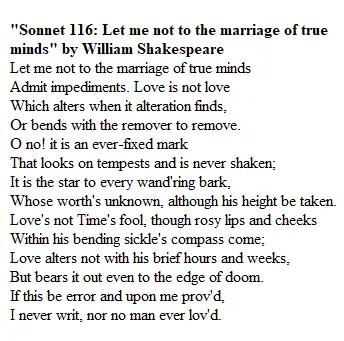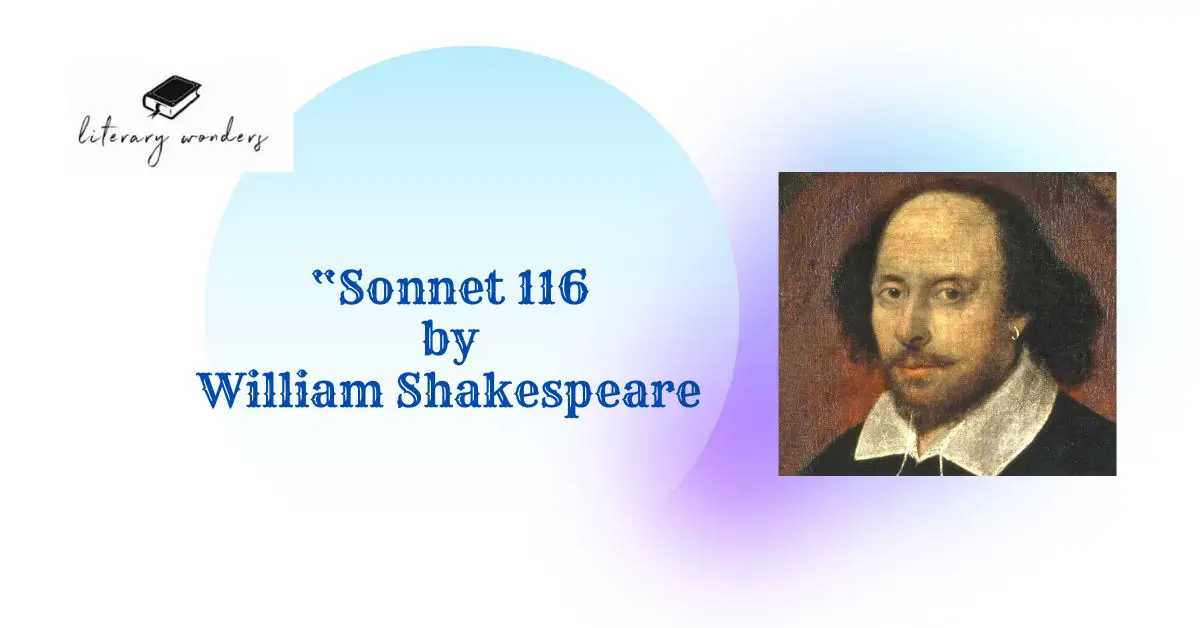Summary of the Poem, “Sonnet 116” Let Me Not to The Marriage of True Minds” by William Shakespeare

- Introduction to “Sonnet 116”: “Sonnet 116″ is a love sonnet written by William Shakespeare, a renowned English poet and playwright. The poem perfectly expresses the sincerity, tenderness, and delight of true love. It also demonstrates how unconditional love can enchant those who choose to embrace it. Because it depicts love as an enduring, immutable connection between two people, “Sonnet 116” became a widely adored poem.
- Representation of True Love in “Sonnet 116”: The poem sings of the glories of unending love. At the outset, the speaker says nothing can separate a couple in love. He says that love isn’t genuine if it alters under adversity. He compares love to a lighthouse that keeps shining through even the worst storms. Additionally, it functions similarly to how stars aid lost sailors. In subsequent lines of the poem, he emphasizes how, while love never changes, a woman’s beauty does. Till death separates two people, love endures all tests of time. The poem ends with the speaker reinforcing the notion of pure love by asserting that if his claims about love are false, no man has ever truly loved.
- Major Themes in “Sonnet 116”: Death, love, and the nature of relationships are some of the poem’s major themes. The author of this poem explores what true love is in depth. He makes an effort to convey the idea that love has the ability to combat time. The waiter highlights that while everything changes with time, love remains constant by bringing up the concept of time in his speech. If the poet, who claims that no man has ever tasted the fruit of true love, is wrong, then he has been honest and confident about his ideas throughout the poem. The author of this love poetry wants to clarify that to have a long relationship, one must be truthful, authentic, and honest.
Analysis of Poetic Elements Used in “Sonnet 116”
Poetic devices are tools that refurbish the simple writings of the writers. Shakespeare has also used many devices in the poem to make it a treat for the reader. The analysis of the devices used in the poem is as follows:
- Assonance: Assonance is the recurrence of vowel sounds inside a single line. Examples include the vowel sound /o/ in “Whose worth’s unknown, although his height be taken” and the vowel sound /e/ in “Or bends with the remover to remove.”
- Allegory: A figure of speech known as an allegory uses characters, figures, and events to represent abstract ideas and ideals. This poem’s allegory discusses the significance of true love.
- Consonance: The repetition of consonant sounds inside a single line is called consonance. Examples are the sound of /r/ in “Or bends with the remover to remove” and the sound of /t/ in “Admit impediments.” Love itself is not love.
- Couplet: A couplet consists of two functional lines of verse united by rhyme and typically written in the same meter. This sonnet concludes with a couplet that typically expresses the poem’s main topic, such as;
“If this be error and upon me prov’d,
I never writ, nor no man ever lov’d.”
- End Rhyme: End Rhyme is used to add melody to the stanza. In this sonnet, Shakespeare uses end rhymes like “Cheeks/weeks,” “minds/finds,” and “mark/bark.”
- Enjambment: Enjambment is described as a poem form in which a concept continues onto the next line rather than ending at the line break. For instance;
“Let me not to the marriage of true minds
Admit impediments. Love is not love
Which alters when it alteration finds,
- Imagery: Using imagery, authors can influence how readers experience things using all five senses. In this verse, Shakespeare uses images like “Or bends with the remover to remove” and “Love’s not Time’s fool, though rosy lips and cheeks.”
- Iambic Pentameter: Iambic pentameter is a style of metre that uses five iambs per line in poems like “Let me not to the marriage of true minds.”
- Metaphor: This figure of speech implies a comparison between two fundamentally unrelated things. To illustrate the true meaning of love, the poet stretched the metaphor of love.
- Personification: Personification is the process of endowing inanimate objects with human characteristics. In the poem’s second quatrain, the author personifies love in the following ways:
“Love’s not Time’s fool, though rosy lips and cheeks
Within his bending sickle’s compass come.”
- Quatrain: A quatrain is a four-lined stanza that was originally used in Persian poetry. Each stanza in this poem functions as a first and second quatrain.
- Symbolism: By providing symbols with symbolic meanings that are distinct from their literal meanings, symbolism uses symbols to represent concepts and attributes. Symbols like love, sincerity, and confidence are displayed in the poem.
FAQs about Shakespeare’s “Sonnet 116” Let Me Not to The Marriage of True Minds” by William Shakespeare
1. What is the main theme of Sonnet 116?
Sonnet 116 explores the theme of enduring and true love. It discusses the idea that true love remains constant and unwavering despite challenges.
2. What does the phrase “marriage of true minds” mean in the poem?
The phrase “marriage of true minds” in the poem refers to the deep emotional and intellectual connection between two individuals. It symbolizes a strong bond founded on mutual understanding.
3. What does the speaker mean by “Admit impediments” in the poem?
It suggests that true love should not be hindered or obstructed by external factors or challenges. The speaker is arguing that real love transcends obstacles.
4. How does the poem describe the nature of love?
The poem asserts that true love remains unchangeable and constant. It’s not influenced by external forces, such as alterations or the passage of time.
5. What does “Love’s not Time’s fool” mean?
This phrase suggests that true love is not subject to the passing of time. It implies that real love doesn’t weaken or diminish as time goes on; it remains steadfast and enduring.
6. How does the poem describe love’s endurance in the face of challenges?
The poem compares love to an “ever-fixed mark” that remains unshaken even during turbulent times. It also likens love to a guiding star for ships, emphasising its constancy and reliability.
7. What is the significance of the line “Love alters not with his brief hours and weeks”?
This line emphasizes that true love doesn’t change or weaken over short periods, like hours or weeks. It remains consistent and unwavering.
8. How does the sonnet view the idea of love changing with circumstances?
The sonnet argues against the notion that love changes based on external circumstances or alterations. It posits that if love does change under such conditions, then it wasn’t true love to begin with.
9. What is the significance of the closing couplet in the sonnet?
The speaker makes a bold claim in the final couplet. If his conception of love is found to be incorrect, he contends, then neither he nor anyone else has ever truly loved.
10. How does Sonnet 116 fit into the broader context of Shakespeare’s work?
Shakespeare wrote 154 sonnets, including Sonnet 116. These sonnets go into a variety of topics, including love, time, beauty, and mortality. The enduring theme of Sonnet 116 on the character and tenacity of true love makes it stand out.
Suggested Readings

